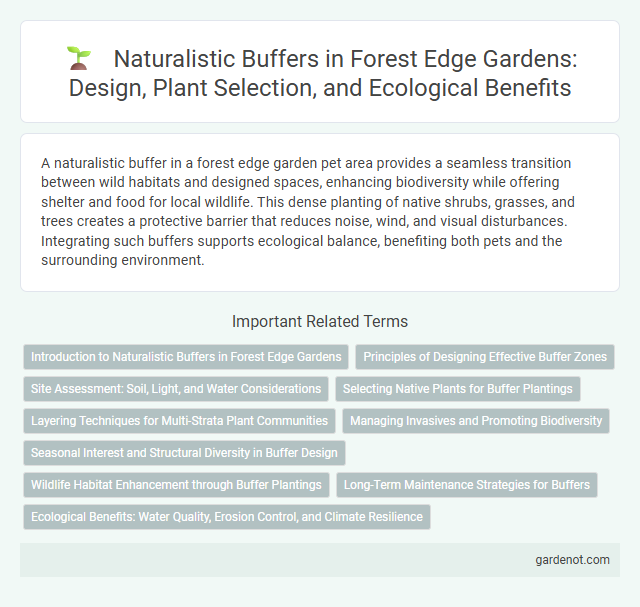A naturalistic buffer in a forest edge garden pet area provides a seamless transition between wild habitats and designed spaces, enhancing biodiversity while offering shelter and food for local wildlife. This dense planting of native shrubs, grasses, and trees creates a protective barrier that reduces noise, wind, and visual disturbances. Integrating such buffers supports ecological balance, benefiting both pets and the surrounding environment.
Introduction to Naturalistic Buffers in Forest Edge Gardens
Naturalistic buffers in forest edge gardens serve as transitional zones that enhance biodiversity by integrating native plant species adapted to forest and open environments. These buffers support wildlife habitats, improve soil stability, and filter runoff, contributing to healthier ecosystems. Incorporating diverse vegetation layers in naturalistic buffers helps create resilience against invasive species and climate fluctuations.
Principles of Designing Effective Buffer Zones
Effective naturalistic buffer zones in forest edge gardens enhance biodiversity by incorporating native plant species that provide habitat and food sources for local wildlife. These buffers reduce soil erosion and filter pollutants, improving water quality and stabilizing the ecosystem. Design principles emphasize layering vegetation with trees, shrubs, and ground cover to create structural diversity and maximize ecological benefits.
Site Assessment: Soil, Light, and Water Considerations
Assessing soil composition and drainage is crucial for establishing a naturalistic buffer in a forest edge garden, ensuring native plants thrive in their preferred substrates. Understanding light availability, from full sun to shaded conditions, guides species selection to match the microenvironment and optimize growth. Evaluating water patterns, including rainfall, runoff, and soil moisture, informs irrigation needs and helps maintain ecosystem balance in the transitional zone between forest and garden.
Selecting Native Plants for Buffer Plantings
Selecting native plants for naturalistic buffer plantings in forest edge gardens enhances ecosystem resilience by supporting local wildlife and maintaining soil stability. Species such as sweet gum (Liquidambar styraciflua), eastern redbud (Cercis canadensis), and Virginia sweetspire (Itea virginica) provide diverse structure, attract pollinators, and adapt well to local climate conditions. Incorporating a variety of native grasses, shrubs, and understory plants creates effective buffers that filter runoff and reduce invasive species encroachment.
Layering Techniques for Multi-Strata Plant Communities
Naturalistic buffers in forest edge gardens enhance biodiversity by utilizing layering techniques that create multi-strata plant communities, mimicking natural forest structures. These layers include groundcovers, herbaceous plants, shrubs, understory trees, and canopy trees, which collectively support wildlife habitats and improve ecosystem resilience. Strategic planting ensures effective soil stabilization, nutrient cycling, and microhabitat diversity, contributing to a sustainable and visually dynamic garden edge.
Managing Invasives and Promoting Biodiversity
Naturalistic buffers in forest edge gardens are essential for managing invasive species by fostering native plant growth that outcompetes unwanted flora. These buffers enhance biodiversity by providing critical habitat for pollinators, birds, and other wildlife, supporting ecosystem resilience. Effective maintenance involves selective removal of invasives and planting diverse native species to ensure long-term ecological balance.
Seasonal Interest and Structural Diversity in Buffer Design
A naturalistic buffer in a forest edge garden enhances seasonal interest by incorporating a diverse array of native perennials, shrubs, and trees that bloom and change foliage throughout the year. Structural diversity is achieved by layering vegetation at varying heights, from ground cover and herbaceous plants to mid-story shrubs and canopy trees, creating habitat complexity that supports wildlife. This design approach ensures dynamic visual appeal and ecological resilience across all seasons.
Wildlife Habitat Enhancement through Buffer Plantings
Naturalistic buffer plantings enhance wildlife habitat by providing essential cover, nesting sites, and food sources for diverse species at the forest edge garden. Strategic selection of native shrubs, grasses, and wildflowers creates layered vegetation structure that supports pollinators, birds, and small mammals. These vegetative buffers also improve ecosystem connectivity, promote biodiversity, and help mitigate the impacts of adjacent land use.
Long-Term Maintenance Strategies for Buffers
Naturalistic buffers in forest edge gardens enhance biodiversity while reducing erosion and nutrient runoff. Long-term maintenance strategies include periodic invasive species removal, selective pruning to promote native plant health, and monitoring soil moisture levels to ensure buffer resilience. Implementing adaptive management practices supports sustainable ecosystem functions and habitat connectivity over time.
Ecological Benefits: Water Quality, Erosion Control, and Climate Resilience
A naturalistic buffer in a forest edge garden enhances water quality by filtering pollutants and reducing nutrient runoff into nearby water bodies. Deep-rooted native plants stabilize soil, significantly controlling erosion and maintaining landscape integrity. This buffer also promotes climate resilience by supporting biodiversity and moderating microclimates, which helps mitigate the impacts of extreme weather events.
Naturalistic buffer Infographic

 gardenot.com
gardenot.com